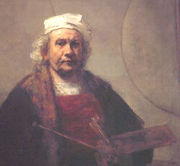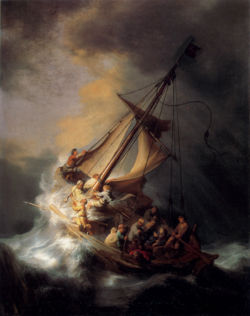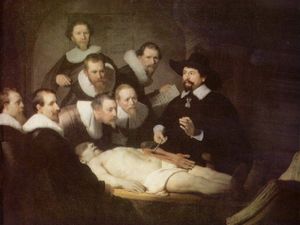Rembrandt
2007 Schools Wikipedia Selection. Related subjects: Artists
| Rembrandt Harmenszoon van Rijn |
|
|---|---|
|
Self portrait by Rembrandt (1661).
|
|
| Born | July 15, 1606 Leiden, Netherlands |
| Died | October 4, 1669 Amsterdam, Netherlands |
Rembrandt Harmenszoon van Rijn ( July 15, 1606 or 1607– October 4, 1669) is generally considered one of the greatest painters and printmakers in European art history and the most important in Dutch history. He also made superb drawings. His contributions to art came in a period that historians call the Dutch Golden Age (roughly coinciding with the seventeenth century), in which Dutch world power, political influence, science, commerce, and culture — particularly painting — reached their pinnacle.
"No artist ever combined more delicate skill with more energy and power," states Chambers' Biographical Dictionary. "His treatment of mankind is full of human sympathy" (J.O. Thorne: 1962).
Works
In a letter to a patron Rembrandt offered the only surviving explanation of what he sought to achieve through his art: the greatest and most natural movement, translated from die meeste ende di naetuereelste beweechgelickheijt. Whether this refers to objectives material or otherwise is open to interpretation; either way, Rembrandt seamlessly melded the earthly and spiritual as has no other painter in Western art..
In all, Rembrandt produced over 600 paintings, nearly 400 etchings, and 2,000 drawings. He was a prolific painter of self-portraits, producing almost a hundred of them (including some 20 etchings) throughout his long career. Together they give us a remarkably clear picture of the man, his appearance, and — more importantly — his deeper being, as revealed by his richly weathered face.
Among the prominent characteristics of his work are his use of chiaroscuro, the theatrical employment of light and shadow derived from Caravaggio but adapted for very personal means; his dramatic and lively presentation of subjects, devoid of the rigid formality that his contemporaries often displayed; and a deeply felt compassion for mankind, irrespective of wealth and age.
His immediate family — his wife Saskia, his son Titus, and his common-law wife Hendrickje — often figured prominently in his paintings, many of which had mythical, biblical, or historical themes.
Life
Rembrandt was born on July 15, 1606 (traditionally) but more probably in 1607 in Leiden, the Netherlands. Conflicting sources state that his family either had 7, 9 or 10 children. His family was quite well to do; his father was a miller, his mother was a baker's daughter. As a boy he attended Latin school and was enrolled at the University of Leiden, although according to a contemporary he had a greater inclination towards painting; he was soon apprenticed to a Leiden history painter, Jacob van Swanenburgh. After a brief but important apprenticeship with the famous painter Pieter Lastman in Amsterdam, Rembrandt opened a studio in Leiden, which he shared with friend and colleague Jan Lievens. In 1627, Rembrandt began to accept students, among them Gerrit Dou.
In 1629 Rembrandt was discovered by the statesman and poet Constantijn Huygens, the father of Christiaan Huygens (a famous Dutch mathematician and physicist), who procured for Rembrandt important commissions from the court of the Hague. As a result of this connection, Prince Frederik Hendrik continued to purchase paintings from Rembrandt until 1646.
By 1631, Rembrandt had established such a good reputation that he received several assignments for portraits from Amsterdam. As a result, he moved to that city and into the house of an art dealer, Hendrick van Uylenburgh. This move eventually led, in 1634, to the marriage of Rembrandt and Hendrick's greatniece, Saskia van Uylenburg. This was obviously a marriage of love. Although she came from a good family (her father had been burgemeester (mayor) of Leeuwarden), Saskia was an orphan and was probably not very wealthy. She lived with her sister in Frisia and did not have many "grand" connections in Amsterdam. These events, however, are widely disputed.
In 1639, Rembrandt and Saskia moved to a prominent house in the Jodenbreestraat in the Jewish quarter, which later became the Rembrandt House Museum. It was there that Rembrandt frequently sought his Jewish neighbours to model for his Old Testament scenes. Although they were by now affluent the couple suffered several personal setbacks; their son Rumbartus died two months after his birth in 1635, and their daughter Cornelia died at just 3 weeks of age in 1638. Only their third child, Titus, who was born in 1641, survived into adulthood. Saskia died in 1642 soon after Titus's birth, probably from tuberculosis.
In the late 1640s Saskia was succeeded in Rembrandt's affections by the much younger Hendrickje Stoffels, who had initially been Rembrandt's maidservant. In 1654 they had a daughter, Cornelia, bringing Hendrickje an official reproach from the Reformed church for "living in sin." Rembrandt was not summoned to appear for the Church council because he was not a member of the Reformed church.
Rembrandt lived beyond his means, buying many art pieces, prints (often used in his paintings), and rarities, which probably caused his bankruptcy in 1656. Because of his bankruptcy he had to sell most of his paintings. He also had to sell his house, and his printing-press, and move to a more modest accommodation on the Rozengracht. Here, Hendrickje and Titus started an art shop to make ends meet. In 1661 he was contracted to complete a series of major paintings for the newly built city hall, this only after the artist who had been previously commissioned died before completing the work.
Rembrandt outlived both Hendrickje and Titus. Rembrandt died soon after his son, on October 4, 1669 in Amsterdam, and was buried in an unmarked grave in Westerkerk.
Periods, themes, and styles
- It was during Rembrandt's Leiden period (1625-1631) that Lastman's influence was most prominent. Paintings were rather small, but rich in details (for example, in costumes and jewelry). Themes were mostly religious and allegorical.

- During his early years in Amsterdam (1632-1636), Rembrandt began to paint dramatic biblical and mythological scenes in high contrast and of large format. He also began accepting portrait commissions.
- In the late 1630s, Rembrandt produced many paintings and etchings of landscapes. Often these landscapes highlighted natural drama, featuring uprooted trees and ominous skies.
- From 1640 his work became less exuberant and more sober in tone, reflecting personal tragedy. Biblical scenes were now derived more often from the New Testament than the Old Testament, as had been the case before. Paintings became smaller again. An exception is the huge The Night Watch, his largest work, as worldly and spirited as any previous painting. Landscapes were more often etched than painted. The dark forces of nature made way for quiet Dutch rural scenes.
- In the 1650s, Rembrandt's style changed again. Paintings increased in size. Colours became richer, brush strokes more pronounced. With these changes, Rembrandt distanced himself from earlier work and current fashion, which increasingly inclined toward fine, detailed works. Over the years, biblical themes were still depicted often, but emphasis shifted from dramatic group scenes to intimate portrait-like figures.
- In his last years, Rembrandt painted his most deeply reflective self-portraits.
Museum collections
- In the Netherlands, the most notable collection of Rembrandt's work is at Amsterdam's Rijksmuseum, including De Nachtwacht ( The Night Watch) and De Joodse bruid (The Jewish Bride).
- Many of his self-portraits are held in The Hague's Mauritshuis.
- His home, preserved as the Rembrandt House Museum in Amsterdam, houses many examples of his engravings.
- Prominent collections in other countries can be found in Berlin, St. Petersburg, New York City, Washington, D.C., The Louvre and the National Gallery, London.
A selection of famous works
- 1629 An Artist in His Studio ( The Museum of Fine Arts, Boston, Massachusetts)
- 1630 The Raising of Lazarus ( Los Angeles County Museum of Art, Los Angeles)
- 1630-1635 A Turk ( The National Gallery of Art, Washington, D.C.)
- 1631 Portrait of Nicolaes Ruts ( Frick Collection, New York)
- 1631 Philosopher in Meditation ( Louvre, Paris, France)
- 1632 Jacob de Gheyn III (the most stolen painting in the world) ( Dulwich Picture Gallery, London, England)
- 1632 Anatomy Lesson of Dr. Nicolaes Tulp ( Mauritshuis, The Hague)
- 1632 Portrait of a Noble (Oriental) Man ( Metropolitan Museum of Art, New York)
- 1632 The Abduction of Europa ( J. Paul Getty Museum, Los Angeles)
- 1633 Christ in the Storm on the Lake of Galilee (formerly at the Isabella Stewart Gardner Museum, Boston; stolen in 1990 and still at large)
- 1635 Belshazzar's Feast (National Gallery, London)
- 1636 The Blinding of Samson ( Städel, Frankfurt am Main, Germany)
- 1636 Danaë ( State Hermitage Museum, St. Petersburg)
- 1642 The Militia Company of Captain Frans Banning Cocq better known as the Night Watch ( Rijksmuseum, Amsterdam)
- ±1643 Christ Healing the Sick also known as The Hundred Guilders Print ( Victoria and Albert Museum, London) etching, nicknamed for the huge sum (at that time) paid for it
- 1647 An Old Lady with a Book (The National Gallery of Art, Washington, D.C.)
- 1650 The Philosopher (The National Gallery of Art, Washington, D.C.)
- 1650 The Mill (The National Gallery of Art, Washington, D.C.)
- 1653 Sacrifice of Isaac ( State Hermitage Museum, St. Petersburg)
- 1653 Aristotle with a Bust of Homer (Metropolitan Museum of Art, New York)
- 1654 Bathsheba at Her Bath ( Louvre, Paris) (Hendrickje is thought to have modeled for this painting)
- 1655 Joseph Accused by Potiphar's Wife (National Gallery of Art, Washington D.C.)
- 1655 A Man In Armour (Kelvingrove Museum & Art Gallery, Glasgow, Scotland)
- 1656 A Woman Holding a Pink (The National Gallery of Art, Washington, D.C.)
- 1656 Jacob Blessing the Sons of Joseph (Staatliche Kunstsammlungen Kassel, Galerie Alte Meister, GK 249)
- 1657 The Apostle Paul (The National Gallery of Art, Washington, D.C.)
- 1658 Selfportrait (Frick Collection, New York)
- 1658 Philemon and Baucis (The National Gallery of Art, Washington, D.C.)
- 1659 Jacob Wrestling with the Angel
- 1659 Selfportrait (Metropolitan Museum of Art, New York)
- 1660 Selfportrait (Metropolitan Museum of Art, New York)
- 1660 Portrait of a Gentleman with a Tall Hat and Gloves (The National Gallery of Art, Washington, D.C.)
- 1660 Portrait of a Lady with an Ostrich-Feather Fan (The National Gallery of Art, Washington, D.C.)
- 1661 Conspiracy of Julius Civilis ( Nationalmuseum, Stockholm) ( Julius Civilis led a Dutch revolt against the Romans) (most of the cut up painting is lost, only the central part still exists)
- 1662 Syndics of the Drapers' Guild (Dutch De Staalmeesters) (Rijksmuseum, Amsterdam)
- 1662 Portrait of a Man in a Tall Hat (The National Gallery of Art, Washington, D.C.)
- 1662-1663 A Young Man Seated at a Table (The National Gallery of Art, Washington, D.C.)
- 1664 Lucretia (The National Gallery of Art, Washington, D.C.)
- 1664 The Jewish Bride (Rijksmuseum, Amsterdam)
- 1666 Lucretia ( The Minneapolis Institute of Arts, Minneapolis)
- 1669 Return of the Prodigal Son (State Hermitage Museum, St. Petersburg)
Night Watch
Rembrandt painted The Militia Company of Captain Frans Banning Cocq between 1640 and 1642. This picture was called the Patrouille de Nuit by the French and the Night Watch by Sir Joshua Reynolds because, upon its discovery, the picture was so dimmed and defaced by time that it was almost indistinguishable and it looked quite like a night scene. After it was cleaned, it was discovered to represent broad day — a party of musketeers stepping from a gloomy courtyard into the blinding sunlight.
The piece was commissioned for the new hall of the Kloveniersdoelen, the musketeer branch of the civic militia. Rembrandt departed from convention, which ordered that such genre pieces should be stately and formal, rather a line-up than an action scene. Instead he showed the militia readying themselves to embark on a mission (what kind of mission, an ordinary patrol or some special event, is a matter of debate). His new approach caused a row, especially among the militia members who ended up at the back of the scene and were hardly visible. Payment was delayed. Parts of the canvas were cut off to make the painting fit on the designated wall when it was moved to Amsterdam town hall in 1715. The painting now hangs in the largest hall of the Rijksmuseum in Amsterdam, where it occupies the entire rear wall.
Expert assessments
In 1968 the Rembrandt Research Project (RRP) was started under the sponsorship of the Netherlands Organization for the Advancement of Scientific Research (NWO). Art historians teamed up with experts from other fields to reassess the authenticity of works attributed to Rembrandt, using all methods available, including state-of-the-art technical diagnostics, and to compile a complete critical catalog of his paintings. As a result of their findings, many paintings that were previously attributed to Rembrandt have been taken from the list. Many of those are now thought to be the work of his students.
One example of activity is The Polish Rider, one of the treasures of New York's Frick Collection. Its authenticity had been questioned years before by several scholars, led by Julius Held. Many, including Dr. Josua Bruyn of the Foundation Rembrandt Research Project, attributed the painting to one of Rembrandt's closest and most talented pupils, Willem Drost, about whom little is known. The Frick Museum itself never changed its own attribution, the label still reading "Rembrandt" and not "attributed to" or "school of". More recent opinion has shifted in favour of the Frick, with Simon Schama in his 1999 book 'Rembrandt's Eyes', and a Rembrandt Project scholar, Ernst van de Wetering (Melbourne Symposium, 1997) both arguing for attribution to the master.
Another painting, "Pilate Washing His Hands", Style of Rembrandt (Dutch, 17th century) Oil on canvas; 51 1/4 x 65 3/4 in. (130.2 x 167 cm) Bequest of Benjamin Altman, 1913 (14.40.610), is also of questionable attribution. Critical opinion of this picture have varied considerably since about 1905, when Wilhelm von Bode described it as "a somewhat abnormal work" by Rembrandt. However, most scholars since the 1940s have dated the painting to the 1660s and assigned it to an anonymous pupil. The composition is reminiscent of mature works by Rembrandt but the Rembrandtesque surface effects fail to convey anything like the master's command of illumination and modeling. The name of his only known pupil of the 1660s, Arent de Gelder, has been put forward speculatively.
"The attribution and re-attribution work remains ongoing. In 2005 four oil paintings previously attributed to Rembrandt's students were reclassified as the work of Rembrandt himself: Study of an Old Man in Profile and Study of an Old Man with a Beard from a US private collection, Study of a Weeping Woman, owned by The Detroit Institute of Arts, and Portrait of an Elderly Woman in a White Bonnet, painted in 1640.
"Rembrandt's own studio practice is a major factor in the difficulty of attribution, as he encouraged his students to copy his own work, sometimes with enough retouching so he could sell them as originals, and sometimes simply to sell as authorized copies. Additionally, his style proved easy enough for his most talented students to emulate. Further complicating matters is the uneven quality of some of Rembrandt's own work, and his frequent stylistic evolutions and experiments. It is highly likely that there will never be universal agreement as to what and what does not constitute a genuine Rembrandt."
A medical analysis of Rembrandt's art talent
In an article published on September 16, 2004 in The New England Journal of Medicine, Margaret S. Livingstone, professor of neurobiology of Harvard Medical School, suggests that Rembrandt, whose eyes failed to align correctly, suffered from stereo blindness. She made this conclusion after studying 36 of Rembrandt's self-portraits.
Because he could not form a normal binocular vision, his brain automatically switched to one eye for many visual tasks. This disability could have helped him to flatten images as he saw, and then put it onto the two-dimensional canvas. In Livingstone's words, this could have been a gift to a great painter like him:
- Art teachers often instruct students to close one eye in order to flatten what they see. Therefore, stereo blindness might not be a handicap — and might even be an asset — for some artists.
Trivia
- In the 2004 election for De Grootste Nederlander (The Greatest Dutchman) Rembrandt came in at ninth place.
- In 2006, the 400th birthday of Rembrandt was celebrated in the Netherlands with a Rembrandtyear. There were special TV programs and a new musical produced by Henk van der Meyden premiered at the Carré Theatre in Amsterdam.
Citations
- ^ ( Hughes 2006, p. 6).
- ^ Adams, Laurie Schneider. Art Across Time. Vol. II. New York: McGraw-Hill College, 1999. p. 660
- ^ ( Clough 1975, p. 23).



